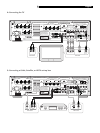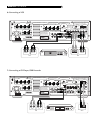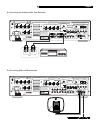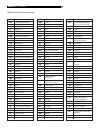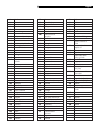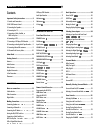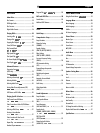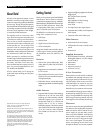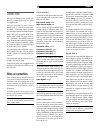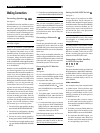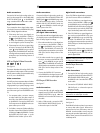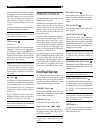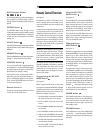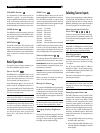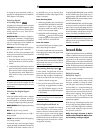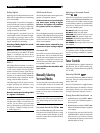
15
English
CONNECTIONS
Although, the RSDX-02’s rear panel looks
daunting, connecting the unit to your system
is straightforward.
There are connections for each of the five
speakers in a 5.1 channel surround system.
In addition, a subwoofer output is provided
for connecting an optional powered subwoofer.
Each of the source components (VCR, TV set-
top box, tape recorder, CD player) in the sys-
tem is connected to the RSDX-02 inputs with
a pair of standard RCA cables for analog au-
dio, a video connection (composite, S-Video,
or Component Video), and an optional digi-
tal audio cable (coax or optical).
The video signal from the RSDX-02 is sent to
the TV monitor using your choice of compos-
ite video, S-Video, or Component Video con-
nections.
The supplied AM and FM antennae are con-
nected to the antenna inputs.
Finally, the AC power cord is plugged into the
back panel of the RSDX-02 and then into an
AC wall outlet.
Notes on connections
There are many ways to configure and hook-
up a surround sound audio system. It is not
possible to cover every configuration in this
manual; therefore, we describe the typical
connections that will work well in a majority
of situations.
The following topics cover a variety of issues
that you might consider when deciding how
to configure your system.
NOTE
: Do not plug any system component
into an AC source until all connections have
been properly made.
Cable selection
Use standard audio cables with RCA connec-
tors for all analog audio connections. Use the
following color code:
Left channel audio: white
Right channel audio: red
You can choose among three different types
of video cables. For composite video, use a
single 75 ohm video cable with an RCA con-
nector at each end. For S-Video, use an S-Video
cable with a special multi-pin connector at each
end. For component video, use a set of three
matching 75 ohm video cables with RCA
connectors at each end. Use the following
standard color code:
Composite video: yellow
Component video (Y): green
Component video (P
B): blue
Component video (P
R): red
NOTE
: Do not use standard audio cables in
place of 75 ohm video cables. Audio cables
will usually pass the signal, but will degrade
the quality.
Use standard optical digital cables for opti-
cal digital signals. Be sure to remove the pro-
tective covers from the back-panel jacks and/
or from the ends of the cable. Use 75 ohm
digital audio cables with an RCA connector
on each end for coax digital audio.
Coax digital: orange
NOTE
: You can substitute a 75 ohm video cable
for a coax digital cable, but do not substitute
conventional audio interconnect cables for
digital signals.
When making signal connections, follow the
color codes carefully at both ends of each cable.
Video Connections
There are three types of video connections
which can be used to connect source compo-
nents to the RSDX-02 or the RSDX-02 to your
TV set: composite video (good quality), S-Video
(better quality), and component video (best
quality). The RSDX-02 cannot convert one type
of video to another; therefore, if you use one
type of connection for a source component,
you must also use the same type of connec-
tion to the TV set.
To simply system configuration, determine which
type of video connection is available on
all
of your source components and then use that
type for every connection. For example, if
your VCR, cable box, and TV all have com-
posite video connections, simplify your system
by using composite video connections every-
where.
This simple configuration may not be ideal in
every situation. For example, with a high-
definition TV set, you must use component video
connections in order to send a progressive scan
signal from the built-in DVD player to the TV
set. Since your VCR doesn’t have component
video connections, you will be forced to use
two different types of video connections. This
will require connecting the RSDX-02 to the TV
set with two different types of connections, one
to each of two inputs on the TV.
Digital Audio
Surround sound formats like Dolby Digital and
DTS are digital recordings. The RSDX-02 can
only decode them when a digital input signal
is available from the source component. A digi-
tal signal is automatically available from the
built-in DVD player so that you can enjoy 5.1
channel sound from Dolby Digital and DTS
encoded discs. In addition, the RSDX-02 pro-
vides connections for digital signals from two
more components, one using a digital coax
cable and one using an optical digital cable.
These digital inputs should be used for any
other components that can deliver a Dolby
Digital signal, such as HDTV receivers, DSB
satellite receivers, or digital cable boxes. You
might also use a digital connection for a CD
player/recorder.
The RSDX-02 has an optical digital output to
send the digital signal from any of the digital
inputs to a digital recorder. When a digital
input source signal is selected for listening, that
signal is automatically sent to both digital
outputs for recording.
NOTE
: When using digital connections, you
may also want to make the corresponding
analog audio input connections.



